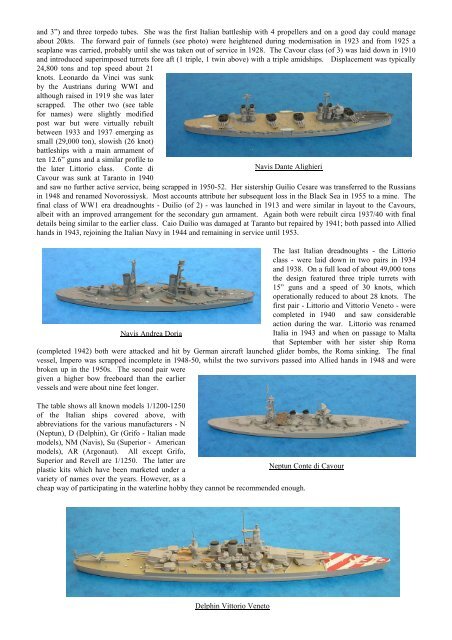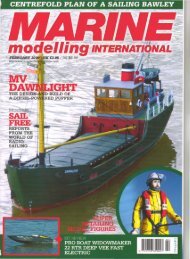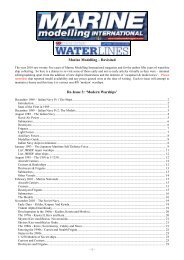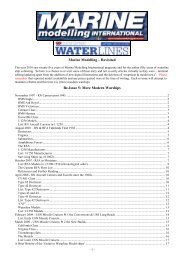Marine Modelling â Revisited Re-Issue 2: 'Foreign Warships'
Marine Modelling â Revisited Re-Issue 2: 'Foreign Warships'
Marine Modelling â Revisited Re-Issue 2: 'Foreign Warships'
You also want an ePaper? Increase the reach of your titles
YUMPU automatically turns print PDFs into web optimized ePapers that Google loves.
and 3”) and three torpedo tubes. She was the first Italian battleship with 4 propellers and on a good day could manage<br />
about 20kts. The forward pair of funnels (see photo) were heightened during modernisation in 1923 and from 1925 a<br />
seaplane was carried, probably until she was taken out of service in 1928. The Cavour class (of 3) was laid down in 1910<br />
and introduced superimposed turrets fore aft (1 triple, 1 twin above) with a triple amidships. Displacement was typically<br />
24,800 tons and top speed about 21<br />
knots. Leonardo da Vinci was sunk<br />
by the Austrians during WWI and<br />
although raised in 1919 she was later<br />
scrapped. The other two (see table<br />
for names) were slightly modified<br />
post war but were virtually rebuilt<br />
between 1933 and 1937 emerging as<br />
small (29,000 ton), slowish (26 knot)<br />
battleships with a main armament of<br />
ten 12.6” guns and a similar profile to<br />
the later Littorio class. Conte di<br />
Cavour was sunk at Taranto in 1940<br />
Navis Dante Alighieri<br />
and saw no further active service, being scrapped in 1950-52. Her sistership Guilio Cesare was transferred to the Russians<br />
in 1948 and renamed Novorossiysk. Most accounts attribute her subsequent loss in the Black Sea in 1955 to a mine. The<br />
final class of WW1 era dreadnoughts - Duilio (of 2) - was launched in 1913 and were similar in layout to the Cavours,<br />
albeit with an improved arrangement for the secondary gun armament. Again both were rebuilt circa 1937/40 with final<br />
details being similar to the earlier class. Caio Duilio was damaged at Taranto but repaired by 1941; both passed into Allied<br />
hands in 1943, rejoining the Italian Navy in 1944 and remaining in service until 1953.<br />
The last Italian dreadnoughts - the Littorio<br />
class - were laid down in two pairs in 1934<br />
and 1938. On a full load of about 49,000 tons<br />
the design featured three triple turrets with<br />
15” guns and a speed of 30 knots, which<br />
operationally reduced to about 28 knots. The<br />
first pair - Littorio and Vittorio Veneto - were<br />
completed in 1940 and saw considerable<br />
action during the war. Littorio was renamed<br />
Navis Andrea Doria<br />
Italia in 1943 and when on passage to Malta<br />
that September with her sister ship Roma<br />
(completed 1942) both were attacked and hit by German aircraft launched glider bombs, the Roma sinking. The final<br />
vessel, Impero was scrapped incomplete in 1948-50, whilst the two survivors passed into Allied hands in 1948 and were<br />
broken up in the 1950s. The second pair were<br />
given a higher bow freeboard than the earlier<br />
vessels and were about nine feet longer.<br />
The table shows all known models 1/1200-1250<br />
of the Italian ships covered above, with<br />
abbreviations for the various manufacturers - N<br />
(Neptun), D (Delphin), Gr (Grifo - Italian made<br />
models), NM (Navis), Su (Superior - American<br />
models), AR (Argonaut). All except Grifo,<br />
Superior and <strong>Re</strong>vell are 1/1250. The latter are<br />
plastic kits which have been marketed under a<br />
Neptun Conte di Cavour<br />
variety of names over the years. However, as a<br />
cheap way of participating in the waterline hobby they cannot be recommended enough.<br />
Delphin Vittorio Veneto<br />
- 10 -







